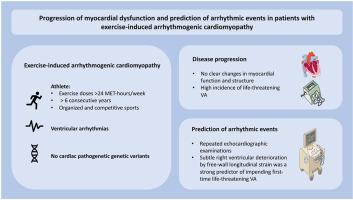运动诱发心律失常性心肌病患者心肌功能障碍的进展和心律失常事件的预测
IF 2.5
Q2 CARDIAC & CARDIOVASCULAR SYSTEMS
引用次数: 0
摘要
背景关于后天运动诱发心律失常性心肌病的报道不胜枚举。本研究旨在探讨心肌功能和结构的演变及其与危及生命的室性心律失常(VA)事件的关系,以确定即将发生事件的标志物。方法我们在一项针对运动诱发心律失常性心肌病(EiAC)患者的三级转诊单中心纵向队列研究中,纳入了患有室性心律失常、无家族史、与心脏病相关的已知基因变异且无其他已确定病因的运动员(每周运动量相当于24个代谢任务小时,连续6年参加有组织的竞技运动)。在长期随访期间,通过重复超声心动图检查评估了心肌功能和结构的变化。结果对 41 名 EiAC 患者(15% 为女性,年龄为 45 ± 13 岁)进行了 80 个月(四分位数区间为 48-115 个月)的随访。在随访期间,所有患者的心肌功能和结构均无变化。我们观察到,EiAC 患者中危及生命的 VA 发生率高,复发率也高。右心室功能的细微恶化与随后的首次 VA 密切相关(几率比 1.12,95% 置信区间 1.01-1.25,P = 0.031,右心室游离壁纵向应变每恶化 1%)。随访期间,右心室游离壁纵向应变的细微恶化是预测即将发生的首次危及生命的VA的有力因素。本文章由计算机程序翻译,如有差异,请以英文原文为准。

Progression of myocardial dysfunction and prediction of arrhythmic events in patients with exercise-induced arrhythmogenic cardiomyopathy
Background
Several reports exist of an acquired exercise-induced arrhythmogenic cardiomyopathy. Little is known about myocardial disease progression and arrhythmia prediction in this population.
Objective
The study sought to explore the evolution of myocardial function and structure and its relation to incident life-threatening ventricular arrhythmias (VA), to identify markers of impending events.
Methods
We included athletes (individuals with exercise doses >24 metabolic equivalent of task hours per week, >6 consecutive years, participating in organized and competitive sports) who had VA, absence of family history and known genetic variants associated with cardiac disease, and no other identified etiology, in a tertiary referral single-center, longitudinal cohort study of patients with exercise-induced arrhythmogenic cardiomyopathy (EiAC). Evolution of myocardial function and structure was assessed by repeated echocardiographic examinations during long-term follow-up. Life-threatening VA were assessed at baseline and during long-term follow-up.
Results
Forty-one EiAC patients (15% women, age 45 ± 13 years) were followed for 80 (interquartile range 48–115) months. There were no changes in myocardial function or structure in the overall population during follow-up. We observed high incidence rate and high recurrence rate of life-threatening VA in EiAC patients. Subtle deterioration of right ventricular function was strongly associated with subsequent first-time VA (odds ratio 1.12, 95% confidence interval 1.01–1.25, P = .031, per 1% deterioration of right ventricular free wall longitudinal strain).
Conclusion
There were no clear changes in myocardial function or structure during follow-up in the overall population, but there was a high incidence rate and high recurrence rate of life-threatening VA. Subtle right ventricular deterioration by free wall longitudinal strain was a strong predictor of impending first-time life-threatening VA during follow-up.
求助全文
通过发布文献求助,成功后即可免费获取论文全文。
去求助
来源期刊

Heart Rhythm O2
Cardiology and Cardiovascular Medicine
CiteScore
3.30
自引率
0.00%
发文量
0
审稿时长
52 days
 求助内容:
求助内容: 应助结果提醒方式:
应助结果提醒方式:


